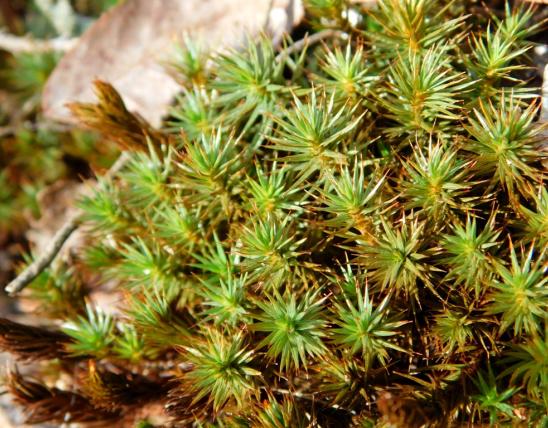
Glossy moss, or shiny or seductive endoton, is a common Missouri moss with broad, glossy leaves that are pressed tightly against the stems. It has a distinctive look. It forms large, dense, glossy green to silver-green to golden-brown mats that sometimes cover an entire boulder or log.
The stems and leaves, together, are round in cross-section, sometimes flattened, and the tightly appressed leaves make this moss look something like a mass of small, shiny green worms.
The leaves are oval to elliptical, to 2 mm long; the outer tip comes to an abrupt point; the leaves are curled (convex) to press tightly against the stem.
The capsules are cylindrical and stand upright; the stalk (seta) is reddish. When the capsules are spent and dry, they often become wrinkled. A key identifier (with magnification) is the outer ring of teeth around the capsule opening: in this species, these teeth are smooth (not ridged or bumpy) and reddish. (It’s the only Entodon species with smooth exostome teeth.)
Learn more about Missouri’s mosses on their group page.
Similar species: There are hundreds of moss species in Missouri, and many of them are pleurocarpous (mat-forming, or carpet mosses). Missouri has about 4 species in genus Entodon. In addition to E. seductrix, we have:
- E. cladorrhizans, or flat glaze moss, is relatively common in Missouri and has rather flattened leafy stems compared to E. sedutrix. But they are not as strongly flattened as E. challengeri; also, E. challengeri’s leaf-tip points are broadly acute (wider), with 1 or 2 teeth at the very tip, while those of E. cladorrhizans are gradually acute (narrower), with tiny teeth (serrations) along the margins (you’ll need magnification to see the teeth).
- E. challengeri, compressed or flattened entodon, has strongly flattened (complanate) leaves that slant downward from the stem like the shape of a rooftop. It is relatively uncommon and is unlikely to be confused with E. sedutrix. For a long time, it was known as E. compressus. When botanists were forced to rename it, it reverted to an older published name, which had been given in honor of the H.M.S. Challenger’s around-the-world oceanography mission in the 1870s.
- E. brevisetus, or short-stalk shiny moss, is a species of conservation concern in Missouri, ranked as critically imperiled. You will probably not encounter it. In North America, it is widely dispersed but uncommon to rare; Missouri is part of the western extreme of its overall range. Like E. seductrix, it has terete (round in cross-section) leafy stems. But it also has long, narrow leaf-tip points (not abruptly pointed), and yellowish (not reddish) capsule stalks.
Stem length: to about 4 inches. Mats of this species can cover large areas such as entire boulders or logs.
Statewide.
Habitat and Conservation
Typically grows in mats on moist, shaded rocks (especially calcareous rocks), soil, logs, and tree trunks and the bases of trees. It is one of the most obvious mosses in wintertime. Because it can survive dry conditions better than many other mosses, it is often found on dry logs or rocks.
Status
Common and widespread.
Human Connections
The genus name, Entodon, is from the Greek entos, meaning “within” or “inside,” and odon, “a tooth.” It refers to the peristome’s inner teeth, which are typically below the mouth of the capsule in this group.
The species name, sedutrix, means “seductress,” from the Latin seduc, which means to “lead astray.” Moss aficionados find humor and poetry in this name, since this moss is common in eastern North America and is indeed quite beautiful and luxurious. People who enjoy mosses can easily be sidetracked by the sight of a beautiful colony of mosses, the way the mythical Lorelei distracted boatmen on the Rhine.
Ecosystem Connections
Mosses and other small, low plants form a microhabitat where many types of insects and other invertebrates live. Earthworms, centipedes, sowbugs, springtails, snails, and a wide variety of other small animals live in and around mosses. Tartigrades, or water bears, are curious microscopic eight-legged animals that often live among mosses. Shrews, salamanders, frogs, tiny snakes, and other insectivores hunt for a variety of small animals among the mosses.
Many kinds of birds, as well as mice and other mammals, use mosses in nest building, relying on their ability to cushion fragile eggs and delicate, naked young; to insulate against cool weather; and to camouflage the nest, concealing it from predators. Even bumblebees gather mosses to use in their nests.
























Mosses, liverworts, hornworts, and lichens seem rather similar, but these organisms are in very different groups. Mosses, liverworts, and hornworts are small, low plants usually found in damp habitats. Unlike more familiar plants, they lack veinlike structures and do not produce flowers or seeds — instead, they produce spores. Meanwhile, lichens are not plants at all: they are a collection of different fungi that have photosynthetic algae living within their tissues.
































